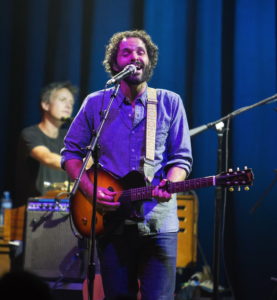
Photo by Nathan Cooper
I first encountered the word “joik” in a linguistics class in my first year of college. It was an example the professor used to demonstrate the way language is not always translatable between contrasting cultures. In english, we would translate “joik” to “song,” the closest word we possess. There are quite a few distinctions between a joik and a song, but my professor focused on one difference: a song, in our culture, is meant to be representative and evocative of its subject. Joiking, to the Sami, is meant to embody the very nature and spirit of who or what it is singing.
As a student of music and songwriting, I was beyond fascinated. But also, synchronistically, it was around this time that I was learning about my own Scandinavian ancestry, and learning that my line comes from the Sami people. It was after that school year that I visited Norway for the first time and my dad showed me places he used to live. We explored Oslo, Bergen, and travelled north, where we learned of the specific Sami village our family comes from.
What I find most amazing about the word joik is that although it illuminates cultural perspectives distinct from our own, most of the concepts it holds are already quite familiar, on a personal level, to any artist. Joiks have a powerful relationship to the communities and culture of Sami. Members of the community are given joiks, and this unique melody ties the individual to traditions and meaning that the community holds. A joik does not belong to the writer. Instead, it is perceived as its own entity, which comes and is given. Joiks are circular, often without beginning and end, mimicking the circular cycles of sun and season. Some joiks have a role in shamanism, used to heal or to change the course of events.
I have a lot to learn still about joiks, but by learning these concepts I can glimpse an idea of the deeply connected perspective the Sami hold with regard to community, ancestry, nature, and art. As a songwriter, most of these concepts seem common sense to me. I hear musicians and artists in my community often expressing these same notions, but without the full vocabulary to connect them to our broader culture.
A couple of years ago was a pivotal point in my life, and I found myself writing songs from a new perspective. A lot was shifting. I found need to write in a way that connected personally to family and community, and which gave to my dad, who was moving through cancer and the end of his life. It was in this time that a few melodies and lines came to me that struck me as sounding like joiks, and so I tried to bring them into songs with that in mind. I included one of them on my recent album, And Then Like Lions. The melodic patterns are influenced by an album of Sami joik field recordings, and the structure of the songs are more circular than how I usually work. Certainly it is an appropriation of an art form that I still have a lot to learn about, but an appropriation with respect in its intention.
The Sami’s story in relation to the established countries their land resides in (Sweden, Finland, Norway, and Russia) is a tragically familiar one to the United States. Religious and economic pressure from these countries in recent centuries has taken land, resources, language, and culture from the Sami. In the 18th century, with the onset of Christianization, joiking was forbidden and regarded as an evil conjuring of spirits and the devil. In the 20th century there was a major planned economic push to wipe out the Sami culture and people completely.
At a unique point in human history, when the world’s dominant cultures are focused almost entirely on what is new and yet to come forth, it’s easy to forget that there are countless invaluable gifts of knowledge and wisdom that have come from a different kind of advancement. They come from our own lines of ancestry and from indigenous peoples around the world. They require our curiosity, our humility, our respect, and our protection. These truths filtered and distilled through the hands of so many generations hold a value beyond measure within any single one.
Leave a Reply